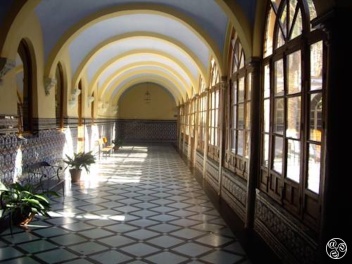Granada
Macia Monasterio de los Basilios
Barcelo Carmen Granada (formerly Sercotal Carmen)
Alhambra Palace
B&B HOTEL Granada Estación (formerly H2 Granada)
AC Palacio de Santa Paula
Parador de Granada
The Parador of Granada enjoys one of the most unforgettable locations in Spain: inside the celebrated Alhambra complex of Christian and Moorish palaces, set high on a hilltop above Granada.
Palacio de los Patos
Sacromonte, Granada
The Sacromonte is famous for the gypsy caves, but the gypsies were neither the first nor the last people to live in them. Long before the Oriental nomads arrived in Spain, the Arabs had discovered that the soft stone of the hill was ideal for carving out underground homes, and gypsies simply moved into them after the conquest.
Tourist Offices in Granada City
Corral del Carbon is one of the oldest Moorish buildings in Granada. Historically the building was used as a coal store, in the 19th century, hence its name. This beautiful patio with cobbles and original Moorish fountain, is now home to the Tourist office and various craft shops.
The Alhambra - The Alcazaba
The Alcazaba, or fortress, is the oldest part of the Alhambra. It was built in the mid-13th century by the Sultan Alhamar, the founder of the Nasrid dynasty, after he fled from northern Andalucia and established what was to be the last Moorish stronghold against the Christian crusaders.
Nightlife
The nightlife in Granada is some of the best in Andalucía. As a world-famous university city, it has a large amount of students, so there is a very eclectic mix of venues and music on offer. From electro, to pop, to rock music; in Spanish, English and Irish bars, you will always find somewhere to suit your musical or atmospheric taste.
Granada City - Fascinating Fact 2 - New Mosque
In 1981 a group of Spanish Muslims, mostly converts, launched plans for a brand new mosque in Granada, funded by various Muslim countries who have never lost their love for the city.
La Cartuja de Granada
Monasterio de Nuestra Señora de la Asuncion - more commonly known as La Cartuja of Granada - is a monastery which once housed Carthusian monks. This monument is often overlooked by tourists in Granada, as it sits away from the main sites, but it is well worth a visit.
The Alhambra Museum
The Museum of the Alhambra is one of the largest and most important museums in Granada, due to the size of the display and the quality of the items on show. The museum claims to have the best collection of both Nasrid and Mudejar art in the world; Nasrid art is extremely rare, being limited to Granada in the 13th to 15th-centuries, when this dynasty ruled the city. As well as art and architectural artefacts from within the monument, you can see other objects from all over Spain.
Corral del Carbon, Granada
The Arabic Word bib means gate and rambla river bank. Until the end of the 19th century, there stood, at the plaza´s east end, a large Moorish gate which gave the place its name - gate of the strand, because it stood on the sandy bank of the river which now flows unseen beneath the Calle de los Reyes Catolicos.
Granada Festival (of Music and Dance)
For more than half a century this amazing festival of international music and dance has brought some of the world’s best musicians and dance performers to Granada bringing the city’s top venues to life.
Generalife gardens of the Alhambra
After the city was conquered, the Generalife was granted by the Catholic Monarchs to the Granada Venegas family. The promenade leads to the "Patio de la Acequia" which is the most celebrated spot and the heart and soul of the palace grounds.
Granada Bus Station
Granada Bus Station is situated on Avenida de Juan Pablo II, in the north west of the city about 3km from city centre. it is the only bus station in Granada having replaced the older 'Camino de Ronda' station in 1995. The metropolitan (urban) red bus line numbers 5, 33 and 21 go from outside the bus staion to different parts of the city. There is a metro stop outside the bus station.
The Alcaicería, Granada City
The Alcaiceria home of the Great Bazaar of Granada, was originally a series of streets between Plaza Nueva and Plaza Bib-Rambla, bursting with stalls selling Arabic silks, spices and other precious goods. Nowadays the only remaining section is Calle Alcaiceria, beginning just off the Calle Reyes Catolicos, and extending back as far as the Cathedral. It is an area rich with history and local culture, still packed with interesting, exotic things to buy.








